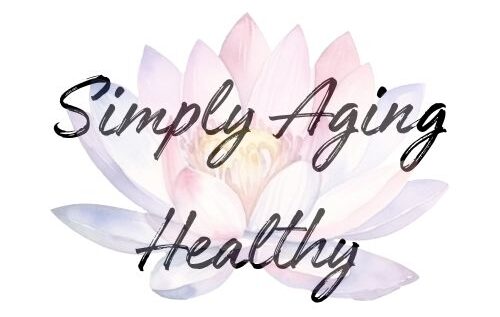Cycling And Lower Back Pain: Tips For a Pain Free Ride (2024)
Cycling And Lower Back Pain: Tips For a Pain Free Ride (2024)
Apr 23, 2023 | Bicycle Tips For Beginners
Updated 3/13/24
We all know that cycling can be an absolutely wonderful exercise with a ton of health benefits.
It’s also a low impact aerobic exercise that is easy on the joints and can help to improve your cardiovascular health and muscle strength.
And oh my gosh, let’s not forget the mental health benefits of cycling!
However, that doesn’t mean that it is all sunshine and rainbows when it comes to this sport. It can also have a few drawbacks for some people.
One big issue I experienced with cycling was a flare-up of lower back pain, especially when riding long distances or when there are a lot of hills on my route.
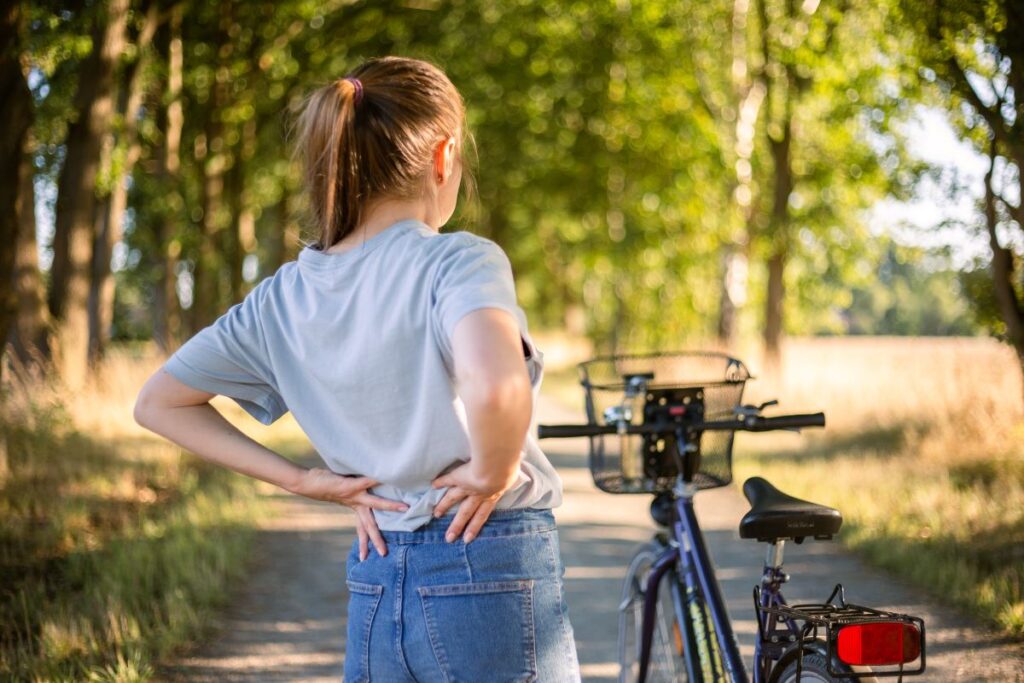
Low back pain is a common complaint in the cycling community and can cause someone to think twice about wanting to cycle.
I know that this was the case for me!
But I truly enjoy cycling and really didn’t want to give up because of a little pain.
OK, so maybe some days it was more of a severe pain that continued even after I got off my bike, making me limit some of my normal activities.
I just thought that if I kept pushing, my back would get stronger, and the pain would just go away.
WRONG!
It just got worse, so I decided to try tweaking a few things to help decrease the pain and make riding fun again.
I found that low back pain while riding can be caused by several things, such as the wrong bike fit, poor core strength, or even your riding technique.
So, in order to get a pain-free ride, you first need to fix whatever is causing your lower back pain.
For me it was focusing on strengthening my core including my lower back muscles due to an arthritic back and adjust my bike seat and handlebars which also improved my riding technique.
A few simple adjustments and/or preventative measures can make riding your bike so much more comfortable and enjoyable.
Understanding Lower Back Pain in Cyclists
While cycling, your lower back acts as a bridge between your legs and arms, helping with power and stabilizing movements.
Pain can be caused by several issues and can impact your ride.
The Anatomy of the Lower Back
Your lower back, or lumbar region, is made up of five vertebrae (L1-L5), intervertebral discs, nerves, and supporting muscles.
These all work together to support your spine and allow for flexibility and strength.
It’s important to keep this area strong and healthy to help prevent lower back pain while riding and when off your bike.
Common Causes of Lower Back Pain
- Muscle Strain: Overuse or incorrect use of back muscles during cycling can lead to muscle strain.
- Core Muscle Weakness: Weak core muscles can put extra pressure on the lower back area, causing back pain.
- Disc Issues: Repetitive cycling movement can irritate conditions of the lumbar spine like herniated or degenerative discs.
- Nerve Compression: Riding long periods of time while sitting in the same position can cause pinched nerves.
The Impact of Cycling Posture
Your riding position directly affects the load on your lower back.
If your handlebars are to far away it can cause you to arch your back excessively
Seat position is another common issue if it is to high or too low it can alter the movement of your hips, affecting your spine.
Rolling your pelvis forward while riding reduces the natural curve of your lower back, leading to potential strain.
How to Fix Lower Back Pain from Cycling
Bike Fit and Adjustments
Ensuring that your bike is properly fitted to your body is crucial for a comfortable ride and to help prevent lower back pain.
The Importance of Proper Bike Fit
Getting your bike fit just right is essential to maintaining good riding posture and reducing strain on your lower back. A proper bike fit will align your body correctly with the bike, allowing for efficient energy use and helping to prevent injuries.
Seat Height and Position
Saddle Height:
Your saddle height affects your pedaling efficiency and comfort.
When your leg is at the bottom of the pedal stroke, your knee should have a slight bend—not fully extended or overly bent.
A good rule of thumb is that you should be able to touch the pedal with your heel at its lowest point without rocking your hips.
Saddle Angle:
The front and back position of your seat can also affect your comfort.
Be sure that the angle of the seat is comfortable for you.
A good article that helped me with this is: Where Should the Sit Bones Be On a Bike Saddle?
Handlebar Position
Handlebar Height:
The height of your handlebars can affect your comfort and control.
Handlebars that are too low can strain your back, while too high can lessen your stability and control.
Be sure to adjust your handlebars to a position where you can maintain a neutral spine.
Handlebar Reach:
The reach to your handlebars should allow you to bend your elbows slightly without stretching.
This positioning helps to absorb shock and prevent overextension of your back.
You can test your reach by making sure that your elbows are slightly bent and that your shoulders remain relaxed while gripping the handlebars.
You may want to go by your local cycling shop for professional help with your bike setup to avoid a poor bike fit.
Trust me, it will be worth your time!
A professional bike fit will help to decrease or eliminate your pain symptoms.
Stretching and Strengthening Exercises
Stretching exercises can help to improve flexibility and reduce muscle tension in the lower back, while strengthening exercises can help to build the muscles that support your spine.
Core Exercises for Cyclists
Core strength is important for cyclists, because it helps you maintain a strong and steady position on the bike, reducing the strain on your lower back.
Here are a few core exercises to add to your routine:
- Plank:
- Position: Lie face down, then lift your body onto your toes and forearms or hands. Be sure that your elbows or hands are below your shoulders.
- Duration: Hold for 30 seconds, increasing as you get stronger.
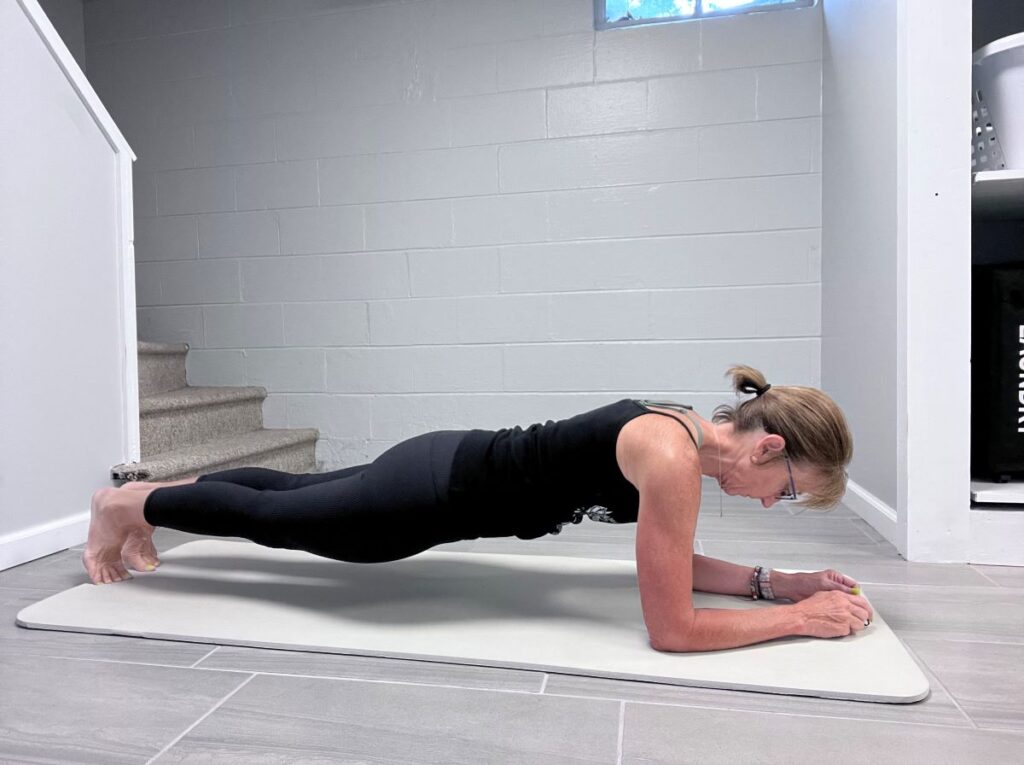
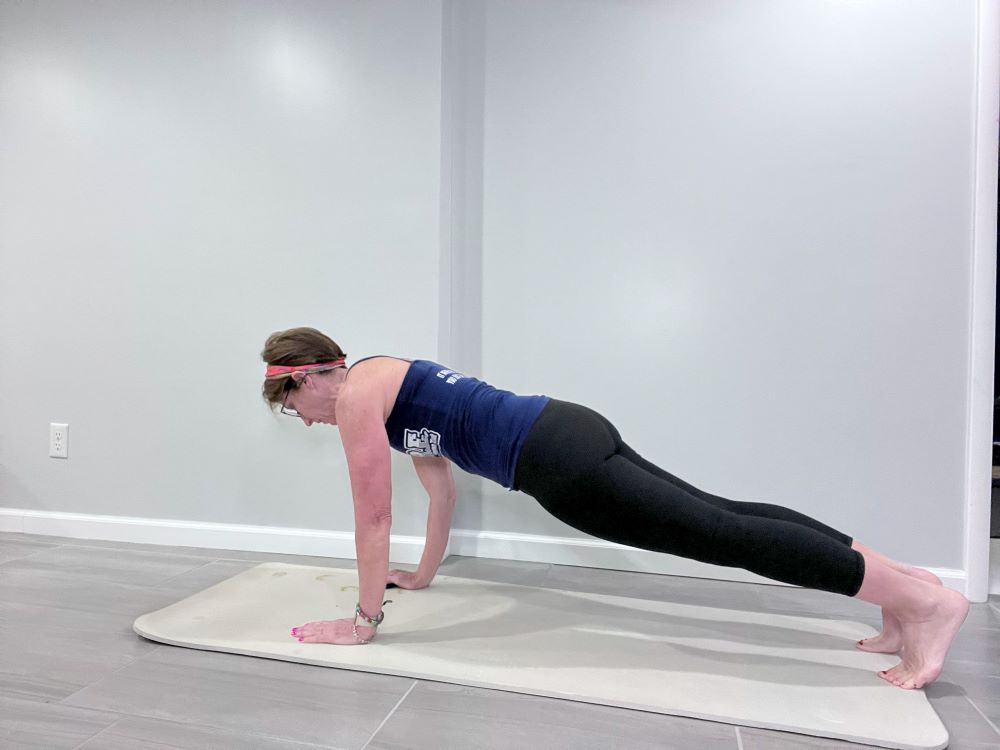
- Bird-Dog:
- Position: Start on hands and knees; extend opposite arm and leg simultaneously.
- Repetitions: 10-15 times on each side..
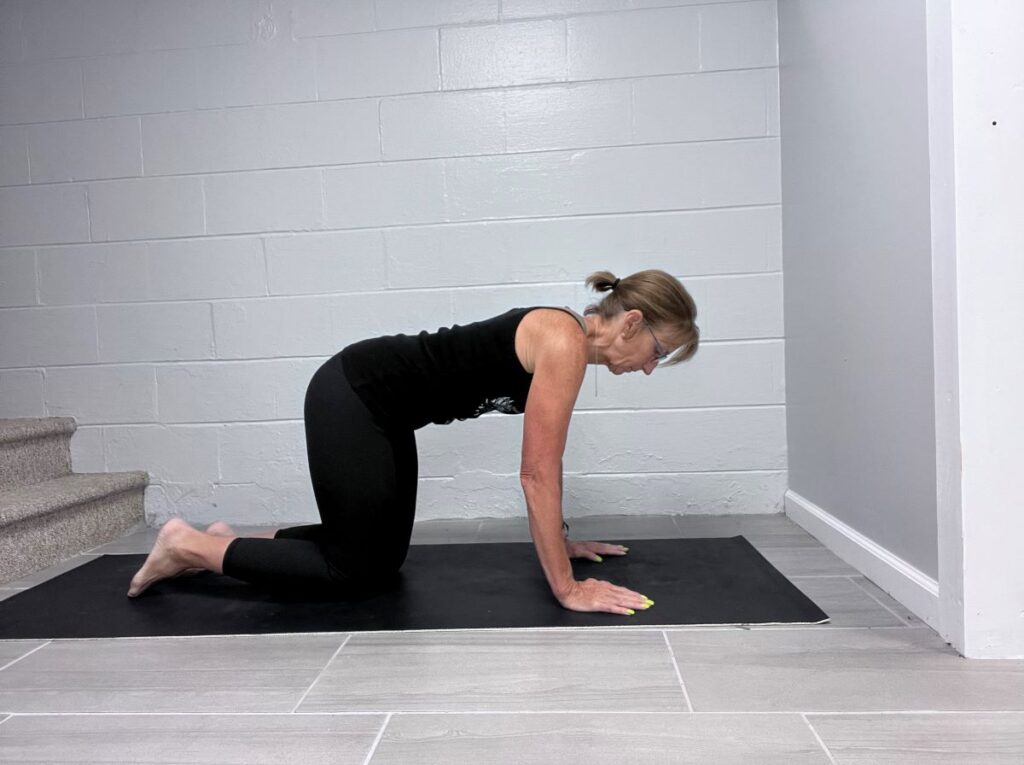
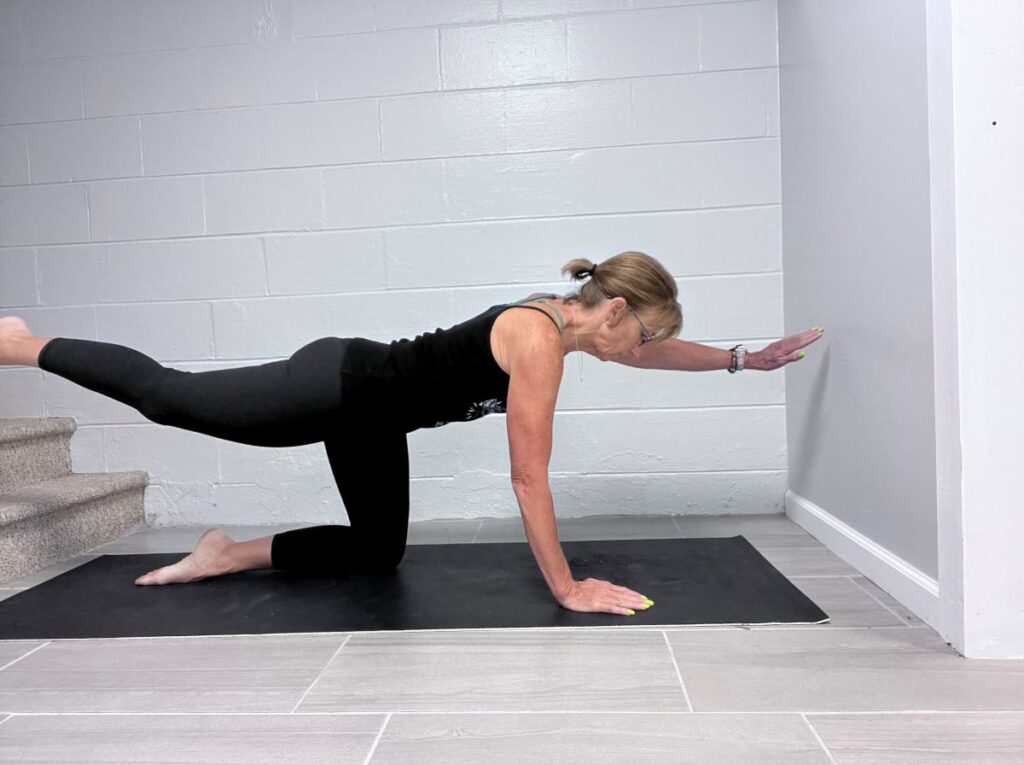
If you’re looking for additional Core exercises, this article may help: 11 Of the Best Core Exercises for Older Adults: How to be a Stronger, Healthier You.
Cycling Lower Back Exercises
To keep your lower back supple and pain-free, try to include these stretches into your daily routine.
- Knee-to-Chest Stretch:
- Position: Lie on your back and pull one knee toward your chest.
- Hold 15-30 seconds on each side.
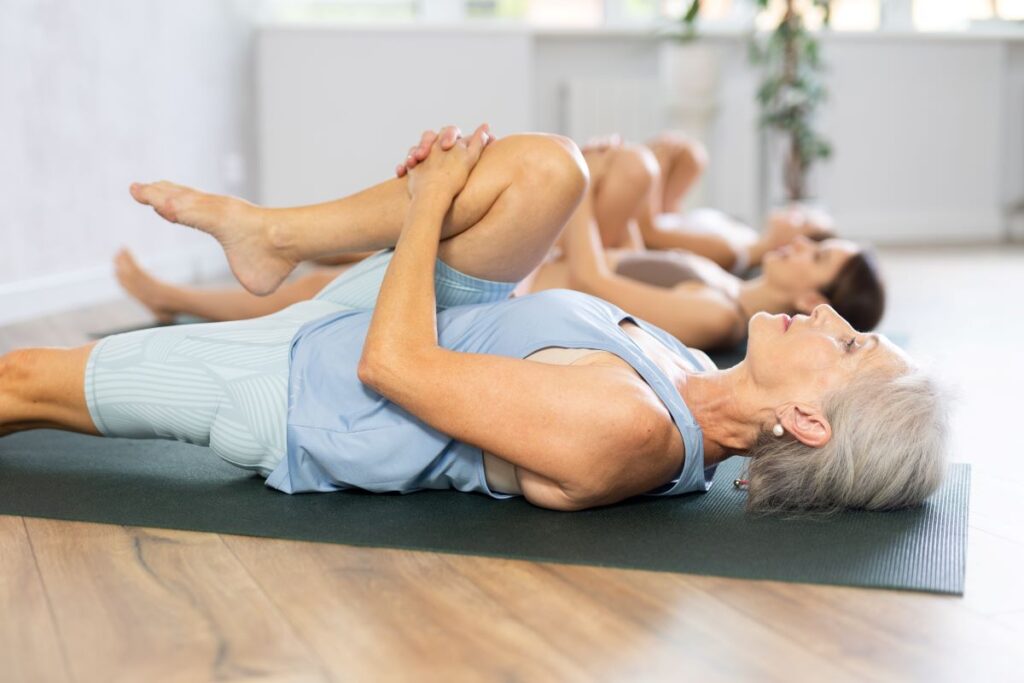
Child’s Pose:
- Position: Start in a kneeling position, sit back on your heels, and stretch forward with your arms.
- Hold: 30-60 seconds.
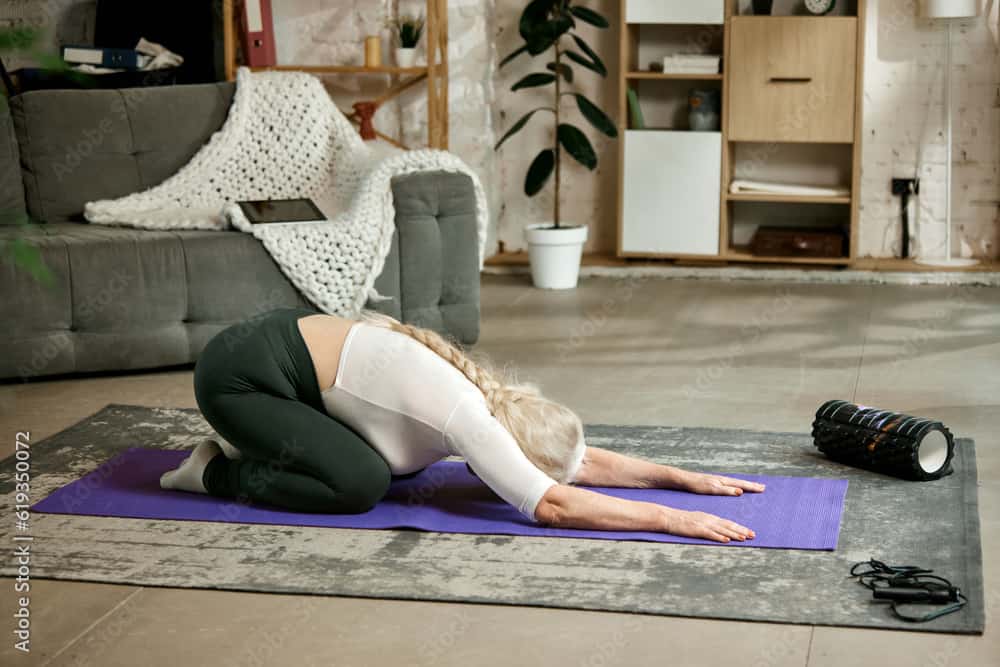
Cross-Training Activities
Cross-training activities can enhance your cycling performance and reduce the risk of lower back pain by balancing your muscle groups and providing flexibility.
- Swimming:
- Benefits: Offers a full-body workout and is easy on the joints.
- Frequency: 1-2 times a week for 30 minutes.
- Yoga or Pilates:
- Benefits: Focus on core strength, flexibility, and mindfulness.
- Frequency: Incorporate 1-2 sessions weekly.
Pre-Ride and Post-Ride Routines
Make your rides more comfortable by adding stretching routines before and after cycling.
Warm-Up Techniques
Before you hop on your bike, it’s important to prepare your body with a targeted warm-up.
Dynamic stretches are best for a warm up routine.
You will want to do 5-10 minutes of dynamic stretching to increase blood flow and flexibility.
Focus on your lower back with movements like leg swings, cat-cow pose, torso twists, and hip openers.
You should also activate your muscles with body-weight exercises like squats and lunges.
READ MORE: Cycling Warm Up For New Riders Over 60
Cool-Down Practices
After your ride, it’s important to cool down correctly to help with recovery and prevent stiffness.
For this you will want to do static stretching for at least 5 minutes to help relax your muscles.
These stretches can include hamstring stretches, piriformis stretches and hip flexor stretches.
You may also consider light activity such as a light walk or slow pedal for 5 to 10 minutes to gradually lower your heart rate.
READ MORE: Stretches After Bike Ride for Seniors – Get Flexible Now
A Few Extra Tips
In addition to proper bike fit and stretching and strengthening exercises, there are a few other tips that can help to prevent low back pain while cycling.
These include:
- Start out slowly. Increase your training gradually to avoid overuse injuries.
- Watch your posture. Don’t slump over your bike – whether your lean forward or in an upright position keep your back in a straight line.
- Don’t forget those padded shorts – yeah, they may look and feel funny but boy can they help reduce low back pain!
- Take Rest Days – Rest days are as important as training days. It gives you body time to recover.
Pain Management and Recovery
Effective pain management and recovery are important so that your cycling does not lead to chronic back pain.
When to Use Heat or Ice
To reduce inflammation and numb the initial pain after a ride, apply ice packs for 15-20 minutes each session during the first 48 hours.
After this period, switch to heat therapy to relax muscles and improve blood flow.
Pain Relief Products
A variety of products can assist in managing lower back pain:
- Topical Creams: Gels or creams containing menthol or capsaicin applied directly can offer temporary relief.
- Pain Medication: Over-the-counter pain relievers such as ibuprofen or acetaminophen can be beneficial; however, consult with a healthcare provider before taking.
Always follow the product instructions and consult with a healthcare provider for advice tailored to your condition.
Rest and Recovery Time
Allowing your body enough time to heal is important.
If you experience mild pain, a day or two of rest may be enough.
For more severe pain, you might need a few days or even a week.
Listen to your body and don’t rush back into cycling.
Gentle activities like walking or swimming can help you keep your fitness level without stressing your lower back.
When to Seek Medical Advice
You should consult a doctor if your lower back pain persists after a week of self-care or if it’s severe and debilitating.
Red flags include pain that radiates down your legs, numbness, or weakness.
Physical Therapy Options
If your back pain persists, your doctor may recommend a few sessions with a physical therapist for options such as:
- Exercise Therapy: Targets the muscles supporting your spine, enhancing flexibility and strength.
- Core Strengthening Exercises: Planks, bridges, and leg lifts.
- Flexibility Workouts: Gentle stretching routines focusing on the lower back and legs.
- Manual Therapy:
- Spinal Mobilization: Gently moving joints to reduce stiffness.
- Massage Therapy: Alleviates muscle tension and improves circulation.
Alternative Treatments
- Acupuncture: Fine needles inserted along energy pathways to reduce pain.
- Chiropractic Care: Spinal manipulation to improve alignment and relieve discomfort.
- Yoga: Poses like Cat-Cow and Child’s Pose can help stretch and strengthen your back muscles.
Always consult with a healthcare professional before starting any new treatment to make sure that it’s appropriate for your specific condition.
Conclusion
Cycling is an aerobic, low-impact sport that offers numerous health benefits, including improved cardiovascular fitness and weight control.
However, it is not without risks, particularly in relation to lower back pain.
The repetitive nature of cycling, combined with a static posture and the need for sustained flexion of the spine, can lead to muscle strains, ligament sprains, and other back-related issues.
To decrease these risks, you should have your bike fitted properly and include core-strengthening exercises and flexibility routines in your training plans to support the lower back.
Also, to prevent tight hamstrings and tight hip flexors you will want to include light exercise for a warm up and a cool down before and after your ride.
Regular breaks and cross-training can also be beneficial in preventing overuse injuries.
Ultimately, a balanced approach to cycling, with attention to posture, bike fit, and overall physical conditioning, can help you maintain a healthy back and a lifelong enjoyment of the sport.
